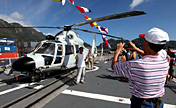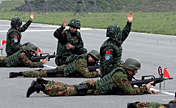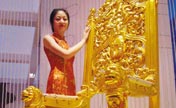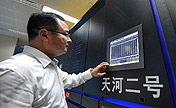

China is back on top of the supercomputing world with the successful operation of Tianhe-2, the world's fastest computer.
A delighted Liao Xiangke, the 50-year-old chief designer, said his team's supercomputing dream will never rest.
"Like astronauts' space dreams and sailors' aircraft carrier dreams, our supercomputing dream is part of the Chinese dream," he said.
On Monday, TOP500, an organization that evaluates high-performance computers worldwide, announced that Tianhe-2 was the world's fastest supercomputer.
It's ultra-high capability of 54.9 petaflops, or 54.9 quadrillion calculations per second, outshone competitors from the United States and Japan. It will provide an open platform for research, education and high performance computing services for southern China.
Jack Dongarra, the US supercomputing expert who compiles the TOP500 list, said there are a number of unique and interesting features of Tianhe-2, including the FT-1500 central processing unit.
Li Nan, deputy chief designer and spokesman for the Tianhe-2 project, said that of the many technological innovations on this "magic instrument", the FT-1500 is "his pride".
Supported by national funding and developed by the National University of Defense Technology, Tianhe-2 was built in just 15 months with a calculation capability 11 times its predecessor Tianhe-1A.
With a peak performance of 4.7 petaflops, Tianhe-1A headed the TOP500 list in November 2010, becoming the first Chinese supercomputer champion. Yet by the end of 2012, the leading position had been lost to the K computer from Japan, and the Sequoia and the Titan from the United States.
Global competition in high-performance computers is fierce, Liao said, and Tianhe-2, facing rivals from the US and Japan, may only keep its edge until 2015.
Li said the US still dominates the high-performance computing field, accounting for half of the top 500 supercomputers in the world.
"That's why nurturing our own supercomputing talent is so important," he said.
 |
 People welcome Chinese missile destroyer "Harbin"
People welcome Chinese missile destroyer "Harbin" CPAPF, Russia's Domestic Security Force joint training
CPAPF, Russia's Domestic Security Force joint training World Naked Bike Ride kicks off in Vancouver
World Naked Bike Ride kicks off in Vancouver Los Angeles' Chinatown sets up statue of Bruce Lee
Los Angeles' Chinatown sets up statue of Bruce Lee Photos:
Photos:  Triplet red pandas enjoy their life at Panda World
Triplet red pandas enjoy their life at Panda World Calling for new type of industry
Calling for new type of industry Double life: Editor with a rock heart
Double life: Editor with a rock heart Memorize the old Beijing with painting brush
Memorize the old Beijing with painting brush Giant panda spotted in the wild in NW China
Giant panda spotted in the wild in NW China Bidding on change
Bidding on change 'The Grandmaste' as opening film of Chinese Film Festival
'The Grandmaste' as opening film of Chinese Film Festival  Gold products:
Gold products:  Daring new collections hit fashion shops
Daring new collections hit fashion shops Tianhe-2 ranked as the world's fastest computer
Tianhe-2 ranked as the world's fastest computer